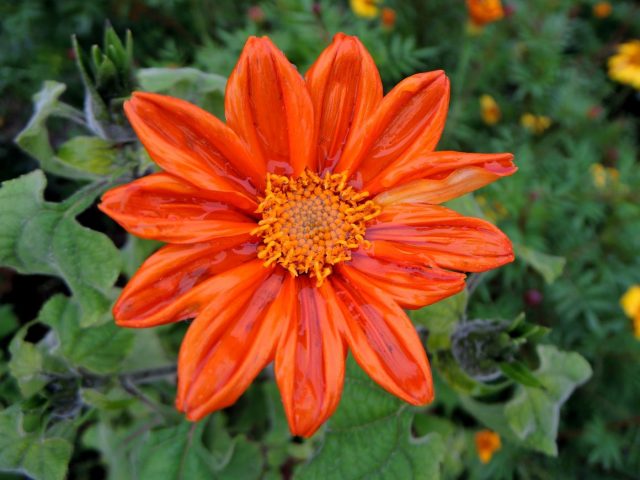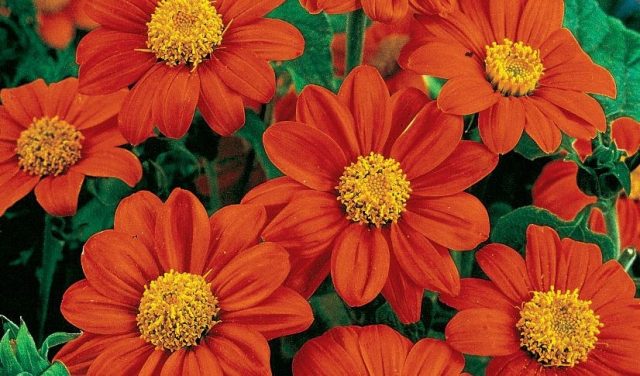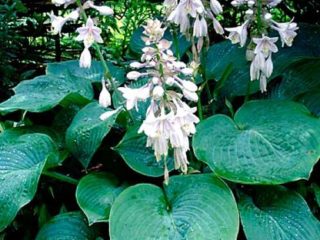Content
Tithonia flower is an exotic representative of plant crops native to Mexico. It is characterized by flaming bright buds that can decorate a flowerbed until late autumn. When planning to start cultivating this heat-loving plant, it is important to familiarize yourself with its characteristics, agricultural cultivation techniques and study all the nuances.

Tithonia represents the Astrov family
What does a tithonia flower look like?
Tithonia in the garden (pictured below) looks luxurious. This flower is a spreading, lush and rather tall (up to 2 m) bush with large buds in baskets of red-orange color, which contrast perfectly with the lush greenery. The stems of the plant are reddish in color, they branch strongly and form a spherical or pyramidal crown, capable of reaching one and a half meters in diameter.
The shoots of the crop are strong and dense and can withstand even strong gusts of wind. They are abundantly covered with beautiful heart-shaped leaves of rich green color, which give the bush even more volume. The leaf blades are alternate, petiolate, with a pointed tip. Their surface is pubescent below and smooth above. They can be three-lobed or solid in shape.
Tithonia inflorescences resemble dahlias, are baskets with a diameter of 5-9 cm, they are mainly colored in orange tones, but red or yellow specimens can be found. The marginal flowers are reed-shaped, the central ones are smaller, tubular, and light in color. The peduncle of the bud is narrow at the bottom, widens towards the top, and hollow inside.
Tithonia blooms abundantly and long-lasting, buds appear continuously, starting from July until snow falls. From the end of summer, the plant produces fruits with tufted achenes, which reach full maturity by October.
Depending on the varietal characteristics, it is a perennial or annual herbaceous crop, a subshrub or even a small tree. Most varieties of the flower grow in the wild in Mexican cities, some species are found in California and Central America, and one variety is found in the southern United States. Tithonia has recently been grown in temperate climates. Only there it grows as an annual.

The homeland of the plant is Mexico, its second name is Mexican sunflower
Is titonia afraid of frost?
Tithonia flower is considered an unpretentious and hardy crop. It feels great on any soil and tolerates extreme heat, but grows poorly in regions with rainy and cloudy weather.Under unfavorable conditions, titonia stops forming buds and slows down in development. This plant is heat-loving and is not frost-resistant; at a temperature of +10 °C and below, its leaves begin to turn yellow and fall off. It should be planted only when the threat of frost has completely passed.
Types and varieties
Currently, eleven species of Tithonia are known, but only two of them are widespread - rotundifolia and diversifolia. The latter is used in herbal medicine and as a biomass that improves soil fertility. Round-leaved plant is grown to decorate landscape design.
Round-leaved
The species Tithonia rotundifolia is an annual plant. It is characterized by highly branched, erect shoots. It can grow up to 1.8 m in height. It blooms with bright and large pubescent buds, reminiscent of a sunflower or dahlia, their diameter can reach 15 cm. The number of petals in a flower is from 8 to 14. The stems of the plant are strong, form a rigid skeleton, and do not always need garter There are many leaves, their size is large, the length can be 14 cm.
The fruits of the flower contain many (up to 200 pieces) small seeds. Their shape is elongated, with several hairs at the end. The ability of planting material to germinate is excellent and lasts for 3-5 years.
Based on natural varieties of the Tithonia flower, breeders have developed original varieties for use in the landscape. Among the most interesting it is worth highlighting:
- Iliad. The species grows up to 100 cm in height. It is characterized by red buds with yellow tubular flowers in the center.
The Iliad exudes a sweet, pleasant aroma
- Goldfinger.The flowers are orange, the stems are strong, 80 to 120 cm high.
Goldfinger stands up well when cut
- Red torch. The buds of the variety range from red to violet-purple in color. Flower height up to 90 cm.
Red torch is often planted in the central part of flower beds
- Torch (Torch). Compact bush up to 50 cm wide, about a meter high. Inflorescences are large, red
Torch can be grown both by seedlings and by seeds
- Sun Festival (Fiesta del Sol). It is a voluminous bush up to half a meter high. This dwarf variety is most suitable for planting in flowerpots and flowerpots. Its buds are presented in orange colors.
Sun Festival - the smallest species of Mexican sunflower
Variegated
Tithonia varifolia is a shrub species that in its homeland can reach three meters in height. The plant has vertical shoots and blooms with large (up to 15 cm in diameter) yellow or orange buds. The leaf blades of a variety of elliptical shape, pointed, up to 40 cm long, are arranged alternately.

Variegated tithonia is designed for growing in hot climates
Growing titonia from seeds
In tropical countries, titonia is propagated by cuttings, but in Russia it is grown using seedlings obtained from seeds purchased in a store or collected independently.
When and how to plant tithonia seedlings
Sowing Tithonia seeds is carried out in early spring, from March to the end of April, usually one and a half to two months before the date of the last frost. It is carried out in loose soil, practically without burying it in the ground. The landing algorithm looks like this:
- Before planting, seeds are soaked in warm water for a day.
- The boxes are filled with soil, planting material is distributed evenly over the surface, and lightly sprinkled with soil.
- Water well, cover with film until shoots emerge (ventilate daily).
- After the seedlings grow true leaves, they are planted in separate containers.
Planting and caring for titonia in open ground
Tithonia is an undemanding flower, but it is advisable to plant it in full sun, in which case the color of the buds will be as intense as possible. It is recommended to choose a site with airy, well-drained, moderately fertile soil. It should always be moist, but not soggy. Acidity is allowed from 5 to 8.5. You should not plant titonia in the wind or draft. If the shoots of the flower begin to bend and bend, then the crown needs to be tied up.

Mexican sunflower can grow in any type of soil
Landing rules
A tithonia flower is planted in open ground when spring frosts definitely will not return. Usually the procedure occurs in the second half of May. Before planting, dig up the soil, add compost to it, and level it. Next, holes are made at a distance of 40 cm from each other, seedlings are placed in them, sprinkled with earth, watered, and covered with mulch.
Watering
Despite the fact that titonia is a drought-resistant flower, it requires systematic watering for good growth and beautiful flowering. The plant especially needs water during the growth stage. Young bushes should be moistened 1-2 times a week. After this, it is advisable to loosen and mulch the soil.
Top dressing
Complex compounds are used as fertilizers for Mexican sunflowers. The best remedy is a mixture of compost and soil. During the active flowering season, it is good to add granular fertilizers for annual flowers to the flower beds.
Trimming
To ensure maximum flowering, Tithonia buds that dry out should be periodically plucked off. Also, in cases where individual plants become unsightly, it is recommended to prune them. This procedure will create conditions for the growth of new shoots.

There is no specific time frame for pruning tithonia flowers; it is done as needed.
Wintering
The plant is an annual and is not prepared for winter. After flowering ends with the arrival of negative temperatures, the bushes are removed from the site along with the roots. Next year, titonia seedlings can be planted again in the same place.
Diseases and pests
Tithonia flower has excellent immunity and almost never gets sick. But with excessive humidity it suffers from rot, which affects its beautiful flowers.
Among insects, slugs, snails and aphids can pose a danger to the crop.
Application in landscape design
Judging by the photo, titonia stands out among the flowers in the flowerbed for its bright appearance. This stately crop acts as a soloist in any composition and goes well with almost all plants. With its help, they decorate the local area, front gardens, ridges, and areas along fences and fences. It looks great on the lawn, near ground covers, and next to other annuals. Low-growing varieties of titonia are planted in pots and placed on loggias and verandas. Mexican sunflower flowers are suitable for cutting and look beautiful in bouquets.

The flower is planted as a honey plant, as it attracts many bees to the site.
Conclusion
Tithonia flower can decorate a summer garden for a long time. The plant is not picky, even beginners in floriculture can grow it. In order for titonia to maximize its decorative qualities, it is enough to choose the right place for it and provide standard care.
Reviews of Tithonia flower













